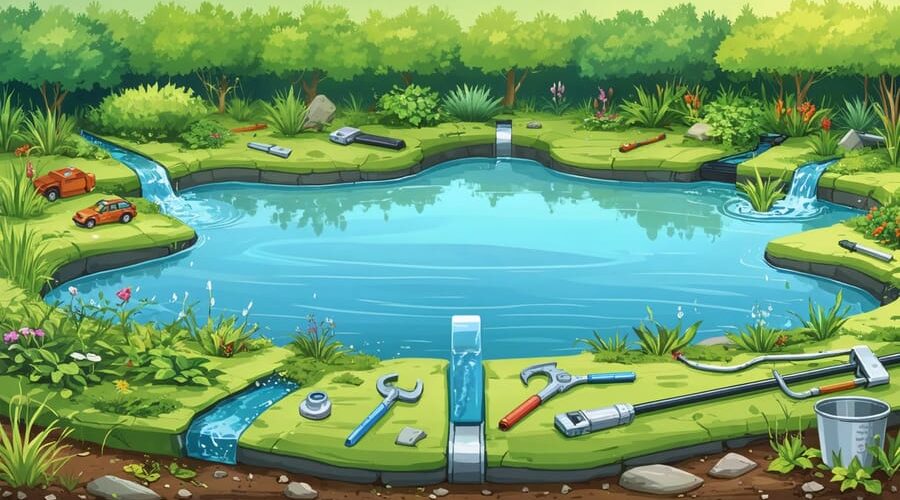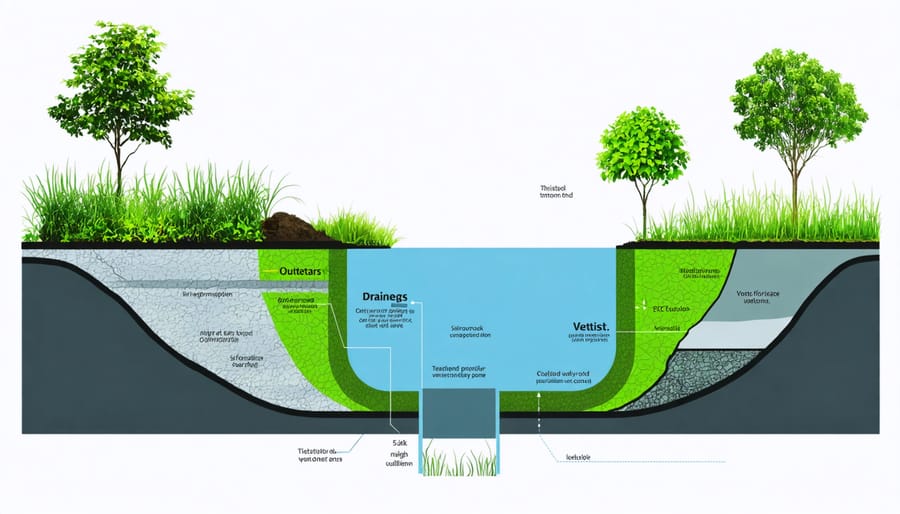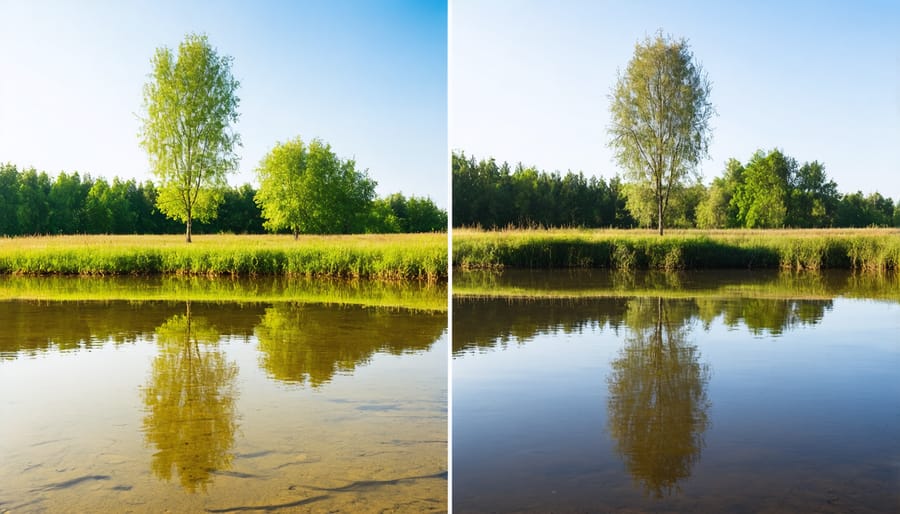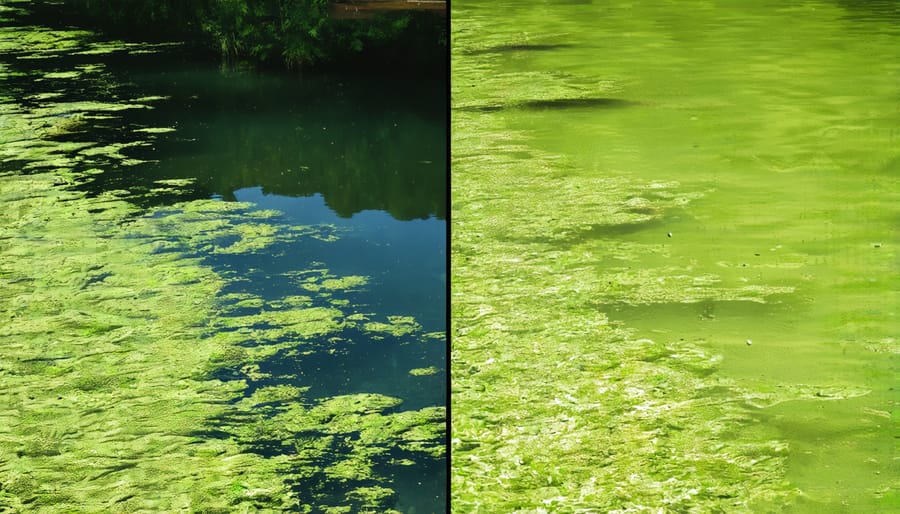
Keep Your Drainage Pond Clear and Healthy (Simple Maintenance That Works)
Regular drainage pond maintenance protects property value and prevents costly flooding disasters. Inspect sediment levels quarterly, removing accumulated debris that reduces water capacity and compromises proper drainage function. Clear vegetation growth from pond banks monthly during growing seasons to prevent root systems from damaging liners and disrupting water flow patterns. Monitor water quality through essential pond maintenance checks of pH, oxygen levels, and algae growth to maintain ecological balance and prevent stagnation.
Schedule professional assessments of drainage structures annually to identify emerging issues before they become major problems. Check inlet and outlet structures weekly during rainy seasons, removing blockages that could lead to overflow. Document all maintenance activities, including sediment removal volumes and water quality readings, to establish patterns and optimize the maintenance schedule for your specific pond system.
This systematic approach to drainage pond care extends the functional life of your water management infrastructure while protecting surrounding landscapes and downstream properties from water-related damage. Proper maintenance not only ensures regulatory compliance but also preserves the aesthetic and environmental benefits these essential water features provide to your property.

Essential Components of a Drainage Pond
Inlet and Outlet Structures
Inlet and outlet structures are the heart of your drainage pond’s circulation system. The inlet structure channels water into your pond during rainfall or runoff events, while the outlet structure controls water release to prevent flooding and maintain proper water levels.
Regular inspection of these structures is crucial. Check your inlet pipes monthly for debris buildup, leaves, or sediment that could restrict water flow. Remove any visible blockages using a long-handled rake or pond net. Pay special attention after storms when debris accumulation is most likely.
Your outlet structure typically includes a principal spillway pipe and an emergency overflow area. Keep the overflow area clear of vegetation and debris to prevent backup during heavy rains. Check for erosion around both structures, as this can compromise their stability and effectiveness.
Look for signs of structural damage like cracks, separation, or misalignment in pipes. These issues can lead to leaks or complete failure if left unaddressed. If you notice significant damage, it’s best to contact a professional for repairs.
Vegetation Zones
A well-maintained drainage pond typically features three distinct vegetation zones, each playing a crucial role in water quality and pond health. The emergent zone, located along the pond’s edge, includes plants like cattails and rushes that help prevent erosion and filter pollutants. The submergent zone, found in deeper water, contains underwater plants such as pondweed that oxygenate the water and provide habitat for beneficial organisms.
The floating zone features plants like water lilies and duckweed that shade the water, helping control algae growth and maintaining cooler water temperatures. For best results, aim to maintain a balance of roughly 40% emergent, 30% submergent, and 30% floating vegetation. Regular trimming and thinning of these zones prevents overgrowth while preserving their beneficial functions.
Remember to remove invasive species promptly and replace dead plants with native alternatives suited to your climate. This three-zone approach creates a natural filtration system that keeps your drainage pond healthy and attractive throughout the year.

Seasonal Maintenance Schedule
Spring Cleanup
As winter’s grip loosens, it’s time to give your drainage pond some much-needed attention. Start by removing any debris that’s accumulated over the cold months – fallen branches, dead leaves, and other organic matter that can clog your pond’s system. Use a long-handled rake or net to safely reach these materials without getting too close to the water’s edge.
Next, inspect your pond’s banks for any erosion or damage caused by winter freeze-thaw cycles. Look for signs of settling or slumping around the edges, and repair these areas with appropriate fill material to maintain the pond’s structural integrity.
Check all inlet and outlet structures for blockages and clear them thoroughly. This is also the perfect time to examine your pond’s overflow systems and ensure they’re functioning correctly. If you notice any significant sediment buildup at the bottom of your pond, consider scheduling a professional cleaning service.
Don’t forget to test your water quality as temperatures begin to rise. Spring is when algae growth can explode, so monitoring phosphate and nitrogen levels can help you stay ahead of potential problems. Taking these proactive steps now will help ensure your drainage pond functions effectively throughout the warmer months ahead.
Summer Management
Summer is when your drainage pond needs the most attention, as warm temperatures and increased sunlight encourage rapid plant and algae growth. Start by monitoring water levels weekly, especially after heavy rains, to ensure proper drainage function. Regular mowing around the pond’s edges helps prevent overgrowth and reduces debris falling into the water.
Keep an eye on aquatic plants and remove any invasive species that might appear. While some vegetation is beneficial, excessive growth can clog your pond’s inlet and outlet structures. Trim back plants that extend more than two-thirds across the water’s surface.
Algae control becomes crucial during summer months. Consider adding beneficial bacteria or barley straw to naturally combat algae growth without harsh chemicals. Check and clean debris screens weekly, as summer storms can wash in leaves and branches that may block water flow.
If you notice unpleasant odors or unusually murky water, test the water quality. These issues often indicate excess nutrients or poor oxygen levels, which are more common in warm weather. Installing an aerator can help maintain healthy oxygen levels during hot spells.
Fall Preparations
As autumn leaves begin to fall, it’s crucial to prepare your drainage pond for the upcoming winter months. Start by removing fallen leaves and debris from the pond surface regularly – letting them sink and decompose can lead to water quality issues and clog your drainage system.
Install a protective net over your pond before the leaves start falling heavily. This simple step will save you hours of cleanup work later. Check and clean all inlet and outlet structures, ensuring water can flow freely through your drainage system during winter storms.
Lower any floating decorations or aerators to prevent ice damage. If your pond has a fountain, consider removing it for the season. This is also the perfect time to trim back any surrounding vegetation and remove dead plant material that could fall into the pond.
Test your water quality one final time before winter sets in. If needed, add beneficial bacteria to help break down organic matter. Finally, mark the edges of your pond clearly – this will help prevent accidents when snow covers the ground and makes the pond’s boundaries less visible.
Remember, proper fall preparation means an easier spring cleanup and a healthier pond year-round.
Winter Monitoring
Even though drainage ponds are less active during winter, consistent monitoring remains crucial for their health and functionality. Regular winter pond maintenance helps prevent potential issues from escalating when spring arrives.
Keep an eye on ice formation, especially around drainage pipes and overflow areas. While some ice coverage is normal, complete freezing can restrict water flow and cause backup issues. Installing a pond aerator or de-icer can help maintain essential water movement and prevent total freezing.
Check your pond’s banks for erosion after winter storms and ensure that drainage channels remain clear of fallen leaves and debris. Remove any accumulated snow from critical areas around inlet and outlet structures to maintain proper water flow.
Monitor water levels regularly, as winter precipitation can affect the pond’s capacity. If you notice unusual changes in water level, inspect for possible leaks or blockages. Remember, addressing minor issues during winter can prevent major headaches when warmer weather returns.
Common Problems and Solutions
Algae Control
Keeping algae under control in your drainage pond doesn’t have to involve harsh chemicals. Several natural algae control methods can effectively maintain clear, healthy water. Start by introducing beneficial aquatic plants like water lilies and floating plants, which compete with algae for nutrients and provide natural shade. Barley straw is another eco-friendly solution – as it decomposes, it releases compounds that inhibit algae growth.
Regular maintenance plays a crucial role too. Remove dead vegetation promptly, as decomposing matter feeds algae. Consider installing a fountain or aerator to keep water moving, which discourages algae formation while adding visual appeal to your pond. Maintaining proper water depth (at least 2-3 feet) also helps prevent excessive sunlight penetration that promotes algae growth.
Remember, some algae is natural and beneficial – the goal is balance, not complete elimination. Monitor your pond regularly and adjust your approach based on seasonal changes and water conditions.

Sediment Management
Sediment buildup is a natural process in drainage ponds, but left unchecked, it can reduce water capacity and affect pond performance. Start by monitoring sediment levels annually, especially after heavy storms. Look for obvious signs like muddy water, visible sediment bars, or decreased pond depth.
For small ponds, you can remove sediment manually using a pond vacuum or rake when water levels are low. Work from the edges inward, being careful not to damage the pond liner. For larger accumulations, consider renting a mini dredge or hiring professionals with proper equipment.
Prevention is key to managing sediment. Install sediment traps at water entry points and maintain vegetative buffers around the pond’s edges to filter incoming water. Regular mowing and debris removal from surrounding areas will also reduce sediment washing into your pond.
Address erosion promptly by reinforcing banks with riprap or native plants. Remember that excessive sediment removal might require permits, so check local regulations before starting major cleanout projects.
Water Quality Issues
Maintaining proper water quality in your drainage pond is crucial for both functionality and environmental health. Regular testing of pH levels, dissolved oxygen, and nutrient content helps prevent common issues like algae blooms and stagnation. Use a basic water testing kit monthly to check these parameters, aiming for a pH between 6.5 and 8.5.
Keep an eye out for warning signs like unusual odors, cloudy water, or excessive plant growth, as these indicate potential water quality problems. Adding beneficial bacteria can help break down organic matter and maintain healthy water chemistry naturally. If you notice dead fish or wildlife, test immediately for oxygen levels and potential contaminants.
To improve water quality, ensure proper water circulation through regular maintenance of pumps and aerators. Remove fallen leaves and debris promptly, as decomposing organic matter can throw off the pond’s chemical balance. During hot summer months, consider supplemental aeration to maintain adequate oxygen levels.
Wildlife Management
A healthy drainage pond supports various wildlife, from beneficial insects to birds and amphibians. While maintaining your pond’s primary drainage function, you can create a balanced ecosystem that enhances your property’s natural beauty. Install native plants around the edges to provide natural habitats and help filter water. However, monitor for nuisance species like mosquitoes, which can be controlled naturally using mosquito-eating fish or bacterial treatments.
Be mindful of seasonal wildlife patterns. In spring and summer, avoid disturbing nesting areas when maintaining your pond. During fall cleanup, leave some plant material for winter wildlife shelter. If geese become problematic, consider installing deterrents like floating devices or border plantings that block their preferred walking paths.
Remember that a well-balanced pond ecosystem actually requires less maintenance, as natural predator-prey relationships help control unwanted pests and algae growth. Regular monitoring helps you spot and address wildlife-related issues before they become problems.
Professional Maintenance Tips
While regular DIY maintenance is essential, there are times when professional help becomes necessary for your drainage pond. Recognizing these moments can save you time, money, and prevent potential problems from escalating.
Consider professional assistance when you notice significant algae blooms that persist despite treatment, unusual water coloration, or foul odors that won’t dissipate. Experts should also be called if you observe structural issues like erosion along the banks, cracks in concrete structures, or problems with inlet/outlet pipes.
Schedule professional inspections at least once every two years, even if everything seems fine. Professionals have specialized equipment to check underwater components and can spot early warning signs that might not be visible to the untrained eye. They can also perform important tasks like:
– Sediment depth measurement and removal
– Professional-grade water quality testing
– Structural integrity assessment
– Advanced filtration system maintenance
– Vegetation management and invasive species control
When selecting a pond maintenance professional, look for certified contractors with experience specifically in drainage ponds. Ask for references and ensure they’re familiar with local regulations regarding water management and environmental protection.
Keep detailed records of professional visits and maintenance work performed. This documentation helps track your pond’s health over time and can be valuable for future maintenance decisions. It’s also wise to develop a relationship with a trusted professional who becomes familiar with your pond’s specific needs and history.
Remember, while professional services may seem costly upfront, they’re often more cost-effective than dealing with major problems that develop from neglected maintenance.
Maintaining your drainage pond is an ongoing commitment that pays dividends in both functionality and aesthetic appeal. As we’ve explored throughout this guide, regular maintenance tasks like removing debris, managing vegetation, and monitoring water quality are essential for keeping your pond healthy and effective.
Remember to stay proactive with seasonal maintenance, particularly in spring and fall when natural changes can significantly impact your pond’s performance. Don’t wait for problems to become severe – addressing small issues promptly can prevent costly repairs down the line.
Keep a maintenance calendar and checklist handy to track your pond care activities. Regular inspections of banks, inlet and outlet structures, and water levels will help you spot potential issues before they become major concerns. Don’t forget to document any changes or repairs you make, as this information can be valuable for future maintenance planning.
While many maintenance tasks can be handled independently, don’t hesitate to seek professional help for complex issues like structural repairs or severe water quality problems. Your drainage pond is an important investment in your property’s infrastructure and environmental health.
By following the maintenance guidelines we’ve discussed and remaining attentive to your pond’s needs, you’ll ensure it continues to serve its purpose effectively while providing a beautiful and beneficial feature for your property. Happy pond keeping!
